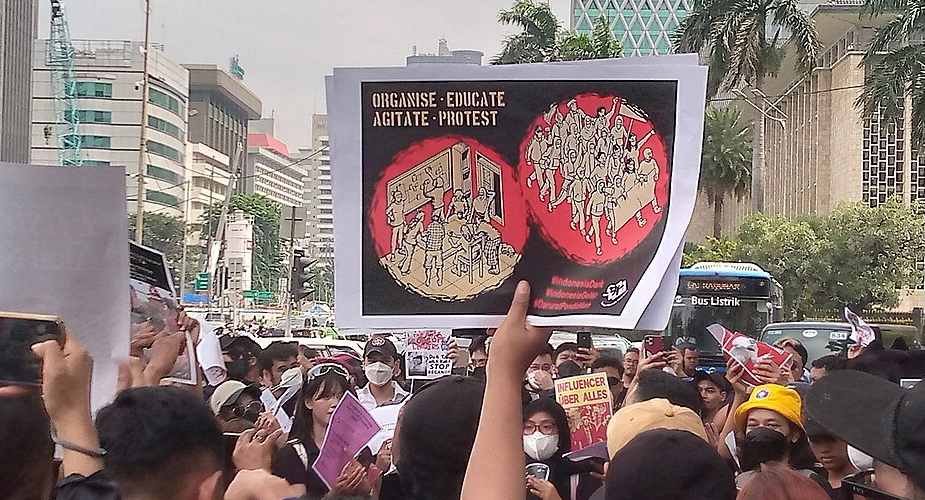Ki Ageng Balak: a friend for those in trouble with the law.
George Quinn
'He likes opium,’ said the elderly lady selling offerings.
I was in the vestibule leading to the tomb of Ki Ageng Balak in the Bendosari sub-district of Sukoharjo south east of Solo in Central Java. I had heard that the saint should be given a diverse array of offerings … but opium?
The lady held up a tiny silver tube capped at one end like a mini tube of toothpaste. I took it between my thumb and forefinger.
‘This is opium?’
‘It is. Only 5000 rupiah.’
I added it to my tray of offerings.
Inside, in the rest area adjacent to the tomb, a group of around 40 visitors were preparing to eat a thanksgiving meal. I sat down among them on the tiled floor and was quietly handed a paper bowl. In it there was rice, shredded chilli peppers, a gulai curry of chicken and beef, and a big, crisp shrimp cracker.
The middle-aged woman who had prepared the meal and who was also one of the tomb custodians (juru kunci) made a short speech in Javanese. She thanked Ki Ageng Balak for the blessings he had bestowed on the pilgrims. She politely thanked the pilgrims too, wishing them good health and safety on their return journey.
We then fell on the food. As I ate, I learned that the party had come from Semarang, two hours away on Java’s north coast. Apparently Ki Ageng Balak had answered their prayers, enabling their leader to successfully complete the building of a house. The simple but delicious food disappeared in a few minutes. In an almost businesslike way, as if the terms of a commercial transaction had been met, the group cleared away the debris of the meal, slipped out to their bus and vanished behind a puff of black diesel exhaust.
I made my way to the inner burial chamber. Near the entry door there was a small iron furnace with a chimney pipe punching up through the ceiling. Ibu Sidem, the juru kunci, knelt before the furnace and sat back on her heels. She took a lump of incense and placed it inside, poking at it with a pair of tongs. As it flared she said a prayer to the saint, beginning with a greeting in Arabic then switching to Javanese. She asked him to protect me from misfortune and pleaded for his blessing on whatever endeavour I might undertake.
I shifted to the air-conditioned interior of the tomb chamber. In the cool stillness a grandfather clock chimed quietly against the back wall. Beside it stood a row of tall, angular, ceremonial umbrellas. I sat cross-legged on a plush carpet beside the saint’s grave. Inside its box-like canopy of white and green drapes I could see a low stack of solid wooden beams. I reached inside and scattered flower petals left to right along the length of the beams. I placed the tube of opium on one of them, silently wishing Ki Ageng Balak enjoyment of the treat.
Saints, tombs and pilgrimages
The tomb of Ki Ageng Balak is one of many hundreds – probably thousands – of sacred sites across Indonesia that are popular places of pilgrimage. Some, like the tombs of Java’s nine Wali Songo saints, are busy all year round and may attract up to a million pilgrims a year. Others are of local or specialist interest only, and may be crowded on just one or two occasions a year. In the last two decades local pilgrimage has burgeoned, especially in Java and Madura, but the practice remains poorly documented and its place in the spectrum of Indonesia’s religious life is not yet well understood.
The tomb of Ki Ageng Balak is usually referred to as Makam Balakan (The Balakan Tomb). On ordinary days never fewer than 10 visitors will arrive at the tomb to pay their respects, but on Thursday nights (malem Jemuwah) hundreds of people regularly turn up.
The site is well-known for its ritual meals. Like the party from Semarang, pilgrims often ‘make a contract’ (nadhar) with the saint. If their wishes are granted – and they usually are, I was told – they repay the saint by holding a ritual meal in his honour at the tomb. As I discovered, if you are lucky enough to be there when a meal is on, you will be invited to join in.
The tomb is at its busiest during the first month of the Javanese year, the month of Suro (also called Muharram). On the eve of the first of Suro – the Javanese New Year’s Day – huge crowds jam the small complex and its surrounds. Numbers again swell in the last week of the month, climaxing in the ceremonial ‘changing of the canopy’ on the last Sunday of Suro.
The old cloth canopy that has shrouded the grave for the previous year is removed. After a year of proximity to the saint it has become permeated with his special power and is highly prized. The cloth is cut into handkerchief-sized pieces and put up for sale to a jostling crowd of buyers. Some pieces are given away as gifts to special guests (I was given a piece during a recent visit).
The new canopy, usually donated by a grateful beneficiary of the saint’s largesse, is then paraded through the narrow lanes of the village flanked by an exotic array of ceremonial umbrellas, spears, bowls of smoking incense and trays of flowers.
But the real focus of attention is a gunungan. This is a cone-shaped mini-mountain of cooked rice liberally garnished with fruit and vegetables hoisted shoulderhigh on a bamboo frame. As the procession approaches the saint’s tomb a heaving mass of people falls on the gunungan, fighting for a fistful of its consecrated rice, even tearing apart the bamboo frame and carrying off its bits and pieces.
Ki Ageng Balak
So who was Ki Ageng Balak? There are two stories. According to the mainstream account he was a prince of the great Hindu-Buddhist kingdom of Majapahit in East Java. During a violent upheaval in the kingdom he fled west into Central Java. There he settled in a dense forest and immersed himself in meditation, acquiring a number of powerful magic charms. When he died the jungle claimed him and the location of his grave was forgotten until its ‘discovery’ in relatively recent times.
Behind this story lurks another story dominated by a menacing Ki Ageng Balak described by one pilgrim who saw him in a dream as being ‘dressed wholly in black with a glowering face and a wide, thick moustache.’ The saint, it transpires, is a friend of those in trouble with the law. People come to the Makam Balakan when they are caught up in a court case or are on the run from police. During his lifetime Ki Ageng Balak was himself a successful criminal, so it is said. In death he has morphed into a kind of underworld Mr Fix-it who can help you avoid the shame and stress of a court appearance, or at the very least can get you a reduced sentence.
But in the visits I have made to Balakan I haven’t been able to get anyone to ‘officially’ confirm this murkier account of the saint’s life. Everyone has insisted, as if in chorus and somewhat defensively, that Ki Ageng Balak lived centuries ago and was an aristocrat of Majapahit.
Maybe. But the story of the saint’s medieval origins could be a kind of mythic cover up – an ‘alibi’ concocted to give the man in black with the thick moustache an air of antique respectability. Equally, it is possible that Ki Ageng Balak’s ‘other life’, that of a twentieth century stick-up man, is a myth too.
In Javanese tradition forests have conventionally been seen as forbidding places to be chopped down and cleared by the forces of order. The forest is fraught with ‘fringedwellers’: wild animals, ghosts, demons, crazy hermits and criminal fugitives. When the saint took refuge in a forest he joined this ragtag category of problematic beings living outside conventional social order. So a juicy modern confection was created out of suggestive elements in the ancient story of the Majapahit noble.
In 2004 the newspaper Suara Merdeka reported that there had been an increase in the number of suspiciouslooking pilgrims who had, in effect, taken up residence in the tomb complex. Villagers in Balakan became concerned that these outsiders were in trouble with the law. People were getting annoyed that the visitors were living too well. By joining in the thanksgiving meals conducted almost daily by grateful pilgrims they were eating better than the local villagers – or so the locals claimed with sour smiles.
Officials and the police stepped up surveillance. They said they would swoop on the site to check the credentials of the freeloaders. Any whose papers were not in order would be sent home. The government didn’t want the tomb to look ‘messy’ (semrawut), they said. But according to one pilgrim the measures were never carried out, at least not thoroughly.
‘The tomb is well-known as a hang-out for people with connections to the criminal underworld, so naturally the police often come here to make arrests. Why would they want to stop anyone, especially criminals, coming here?’
And anyway, today the tomb is part of the Sukoharjo district’s tourism promotion strategy. A government operated ticket box stands outside the entrance. Revenue from it contributes to the district’s ‘locally generated income’ (PAD). The powerful prince of Majapahit and the opium-smoking friend of criminal fugitives both have a role to play in maximising this revenue. ii
George Quinn (george.quinn@anu.edu.au) heads the Southeast Asia Centre in the College of Asia and the Pacific, Australian National University.











